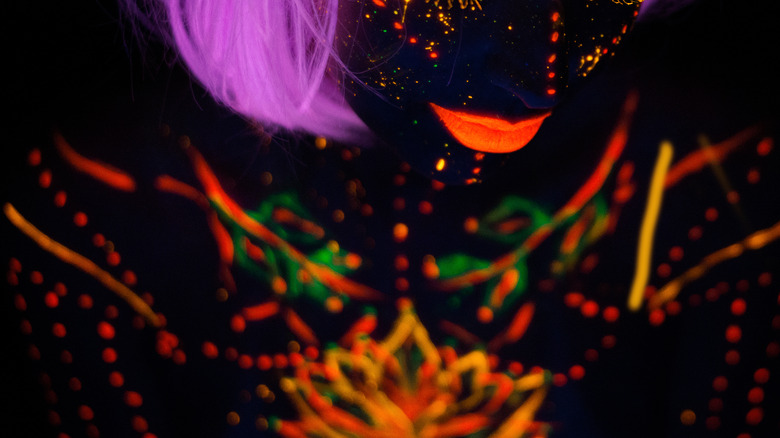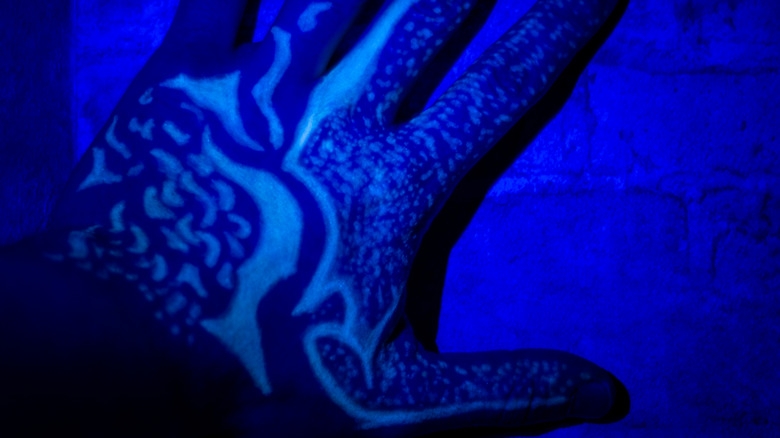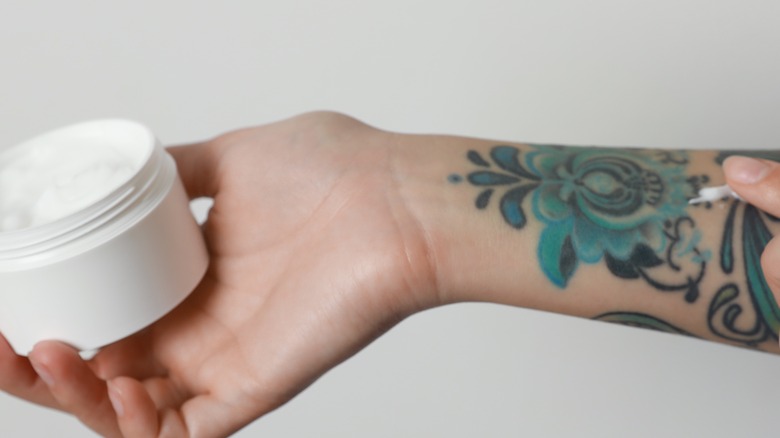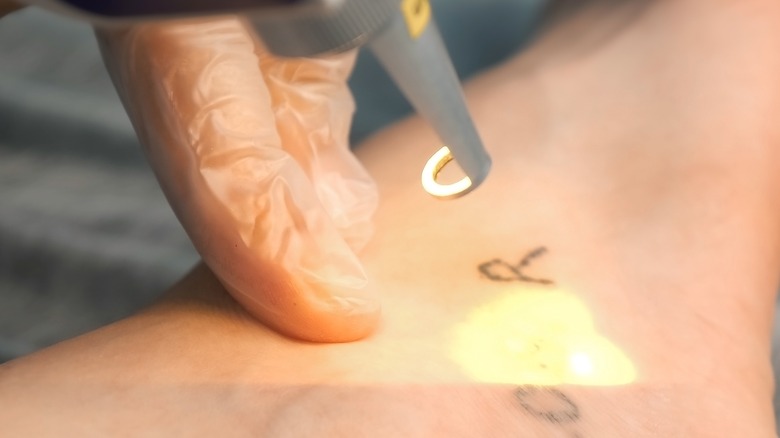What To Know Before Getting A Trendy Glow-In-The-Dark Tattoo
When it comes to body modification, trends are plentiful. And when a trend is hot, people jump on the bandwagon because that's what trends are for. The latest trend in the world of decorating your body is glow-in-the-dark tattoos. Yes! Remember all those glow-in-the-dark stickers you had on your ceiling as a kid? Well, now you can have them on your body. Dreams really do come true.
Unlike traditional tattoos, glow-in-the-dark tattoos are made with fluorescent colors that can't be seen during the day — just like those stickers you had in your bedroom. But where these two delights differ is that a glow-in-the-dark tattoo isn't going to light up at night once you turn off the lights.
"These types of tattoos are actually only visible under black lights," celebrity tattoo artist Dillon Forte tells Byrdie. "Knowing that most of us aren't hanging out at raves these days or planting black lights all around our rooms, we probably won't have many chances to see the tattoo light up. For your typical blacklight tattoo, the artist has to be careful not to mix standard, darker pigments too close to the zinc sulfide as it may reduce its 'glow.'"
If you're not old enough to remember black lights, then ask your parents or someone who was a teenager in the 90s; they'll certainly know what it is. If this all sounds intriguing and you're thinking this might be the tattoo you've always wanted, there are some things you want to know first. You know, it's always best to have a heads up before jumping into something that's permanent. Because tattoos hurt even worse when they're removed, even if you can't see them very well in the daylight (via Healthline).
The name is misleading
As mentioned, these tattoos don't actually glow in the dark. You can try to put them in the sun for 20 minutes and see if they glow when the lights go off, but you're going to be very disappointed when they won't. So you need to ask yourself if you're under a black light often enough for this type of tattoo (via Allure). If the answer is no, then maybe this isn't the best kind to get.
Of course, you could carry around a black light with you no matter where you go, and that can be your thing, so everyone can get a peek at your glow-in-the-dark tattoo. At some point, however, being the person with the black light at the bar, the 24/7 diner, the party, the metro, and everywhere else is going to wear itself out.
Furthermore, this invisibility factor can make getting the tattoo a little tricky (via Cosmopolitan). So, you definitely want to work with an artist who's experienced in this type of tattooing.
The safety factor
Although it might seem like something that's going to make your tattoo glow under a black light would probably be unsafe, glow-in-the-dark tattoos are actually quite safe (via Elle). While UV light tattoos have been around since the '90s, the ink that's used now is very safe because artists no longer use phosphorus ink to create the glow. Instead of phosphorus, tattoo artists use ink that reacts when put under a black light.
However, if you're new to tattoos or don't know anything about them, tattoo ink isn't regulated by the U.S. Food and Drug Administration (via USA Today). This, of course, shouldn't be a dealbreaker, especially if you look at all the tattooed people in the world doing just fine. But an allergic reaction to tattoo ink isn't unheard of. Red ink is usually the one that negatively reacts with people's skin the most, resulting in slight skin irritation (via Everyday Health).
The cost of these tattoos
What will your glow-in-the-dark tattoo set you back? Well, it depends on the size, where on your body you want it, and where you go to have it done (via Saved Tattoo). In general, if you get a tattoo at a hipster studio in Brooklyn or San Francisco, it's going to cost far more than if you get a tattoo at a strip mall in Ohio. That's just because everything is more expensive in larger cities. But when it comes to whether this kind of tattoo will cost you more, the answer is yes — but not by much.
"Typically, I only charge a little bit more," tattoo artist Scott Cook of Independent Ink tells Bustle. "The main difficulty is having a black light next to you as you work ... [and it's] a little bit harder to get into the skin." That little bit more in price is about $50 to $100 per tattoo.
The aftercare for glow-in-the-dark tattoos
Despite the fact that the ink might be a little different, the aftercare for a UV light tattoo is exactly the same as a traditional tattoo (via Allure). That means that after your tattoo is finished, the artist will apply a thin layer of ointment, then cover it up with plastic or cling wrap. You can remove the protective plastic a few hours later and gently wash it with mild soap. You shouldn't take long, hot showers for the first few days so the tattoo doesn't get too moist, and you should stay out of the sun and continue to apply a layer of ointment for up to two weeks. Most artists recommend A+D ointment or something similar, like Aquaphor.
If you should experience an allergic reaction, as UV ink has a slightly higher rate of causing skin issues than traditional ink, then keep an eye on it (via Tattoo Health). Bumps and rashes aren't a big deal, but swelling, pain, dizziness, heart palpitations, and breathing trouble are indicative that you're having a serious reaction and need immediate medical care (via the American Academy of Dermatology Association).
The long-term effects of glow-in-the-dark tattoos
Because UV tattoos are relatively new to the world of tattooing, exactly how long they'll last has yet to be determined (via Medical News Today). Glow-in-the-dark tattoos could last your entire life like traditional tattoos, with minimal fading, as long as they're taken care of — meaning keeping them out of the sun and/or using sunblock every time you venture into the sun.
Also, like traditional tattoos, you can have them removed if you decide you no longer want your somewhat-invisible tattoo or the novelty of carrying around a black light has worn off. However, and you definitely want to pocket this important bit of information, the lighter the tattoo, the more difficult it is for a laser to remove it. That being said, if you really no longer want it, then it might need to be cut out of your skin (via Byrdie). The results of that are likely to be far more noticeable than your glow-in-the-dark tattoo ever was, so please seriously take this fact to heart before diving into this trend.





